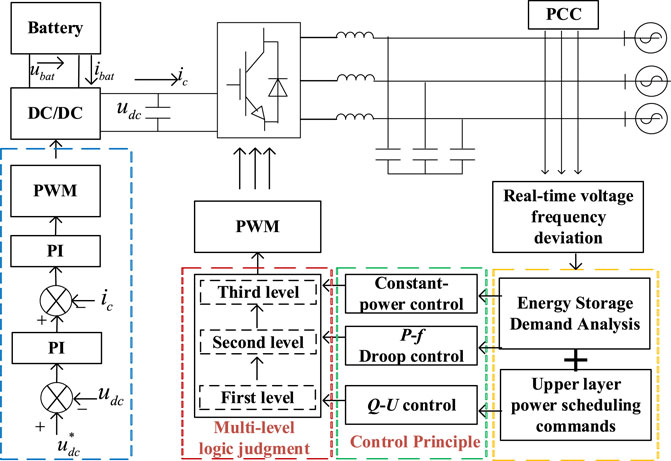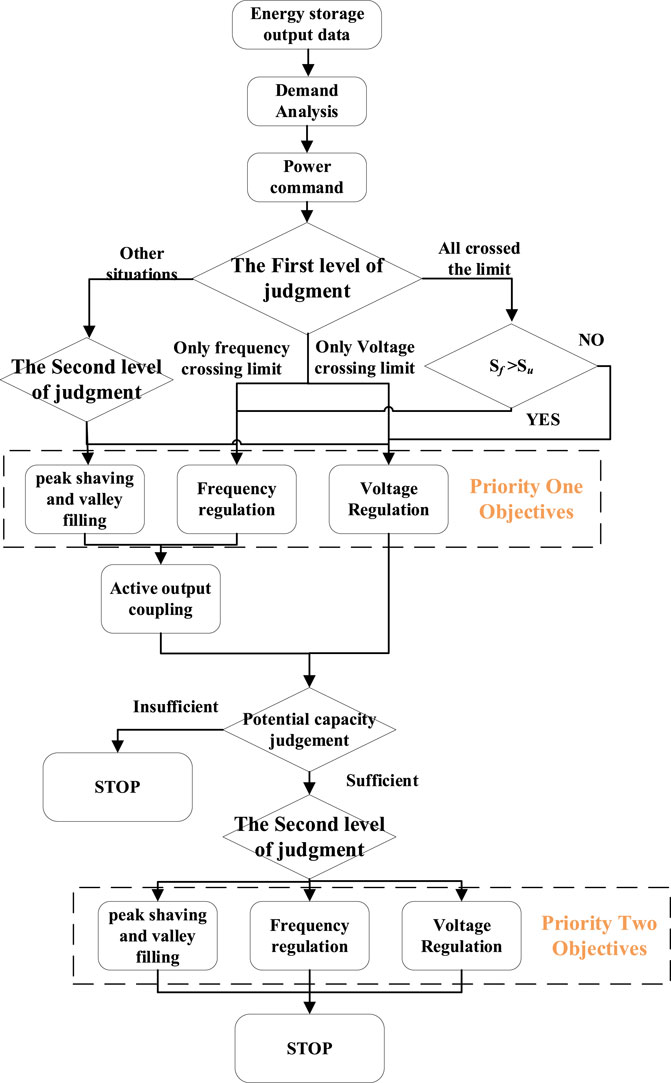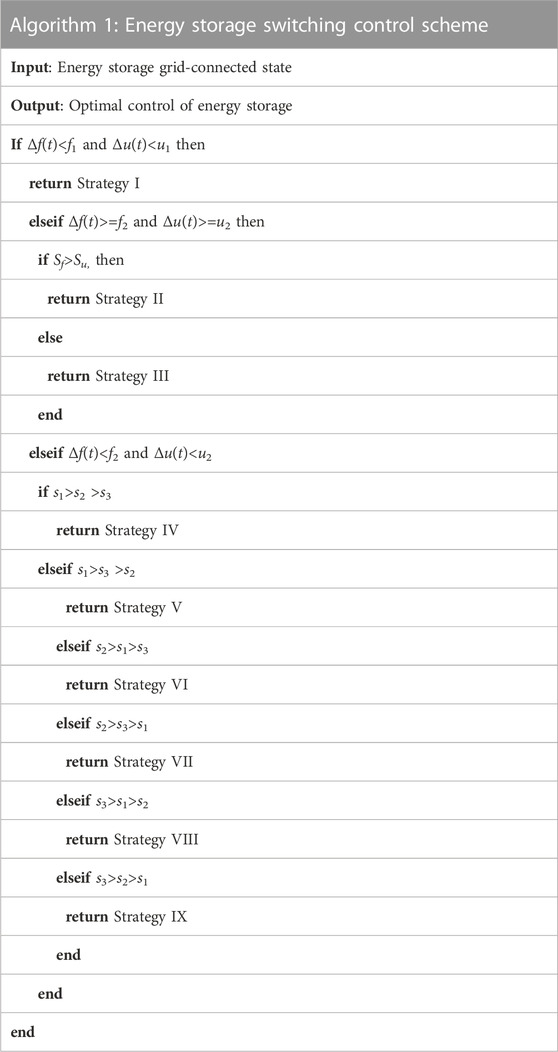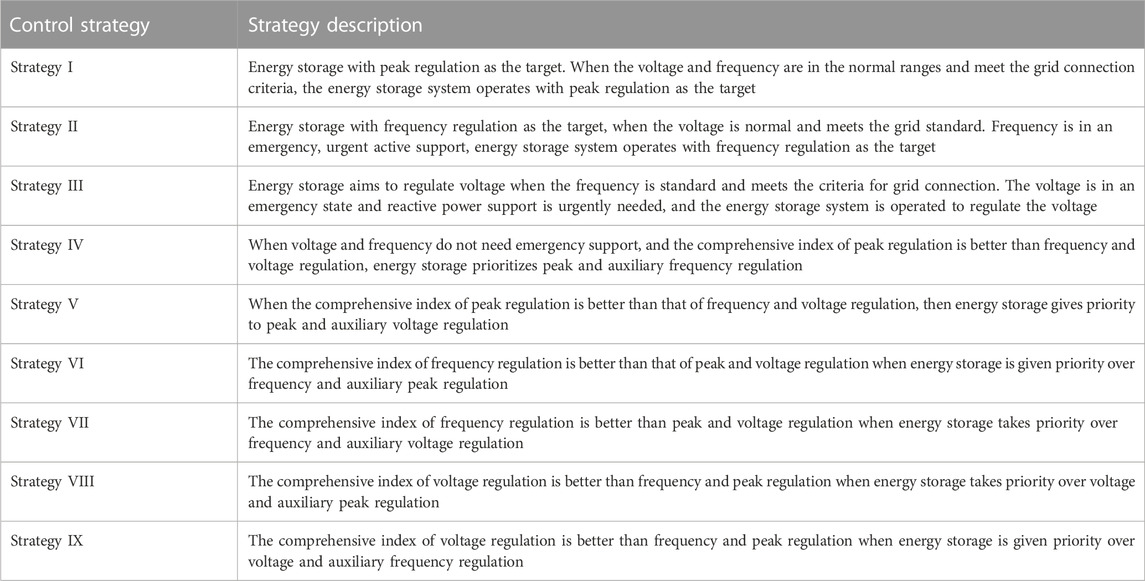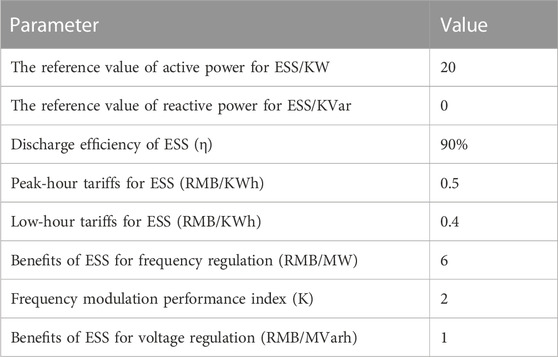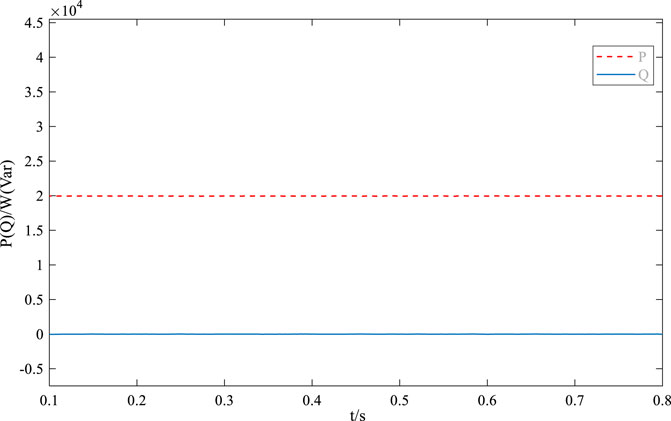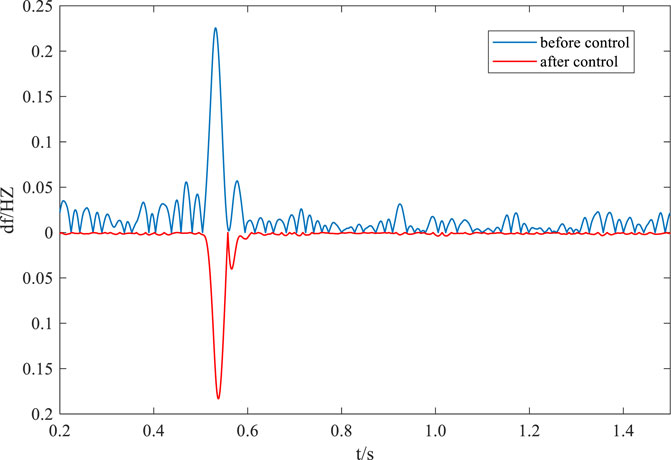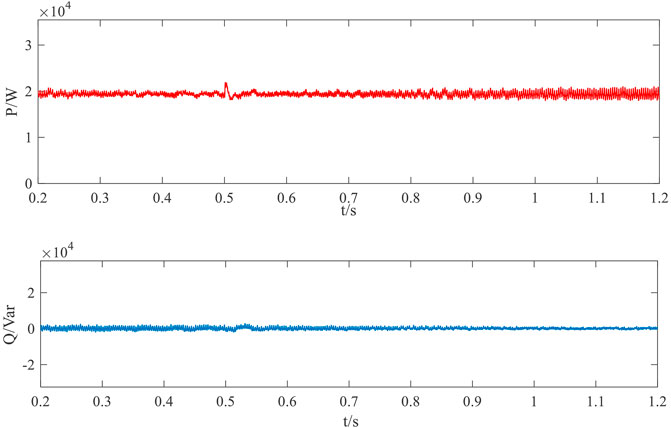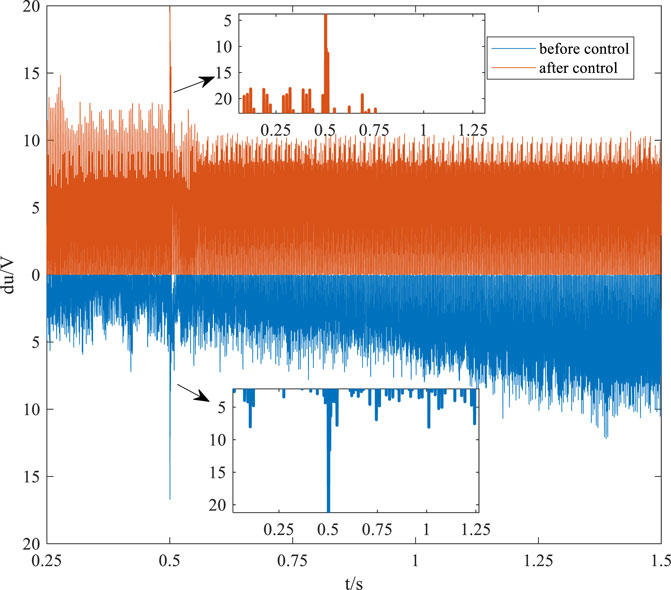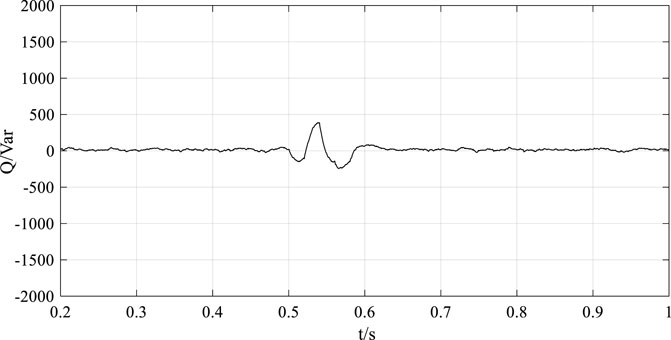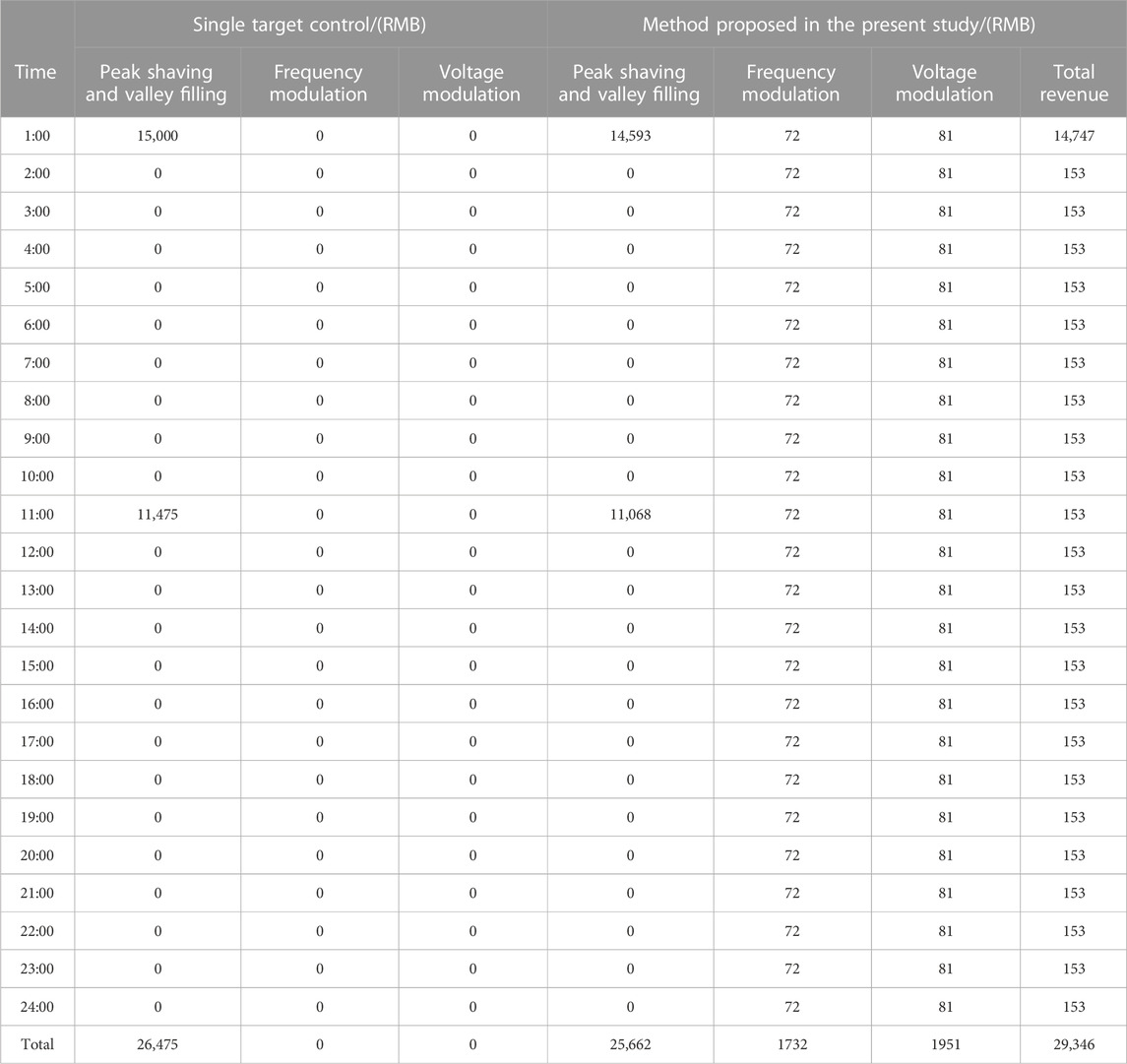- 1Economic and Technology Research Institute, State Grid Shandong Electric Power Company, Jinan, China
- 2School of Electrical Engineering, Shandong University, Jinan, China
Energy storage is a new, flexibly adjusting resource with prospects for broad application in power systems with high proportions of renewable energy integration. However, energy storage systems have spare capacity under stable working conditions and may be idle for some periods. These actions are primarily selected for peak shaving and valley filling, frequency regulation, and voltage regulation as the only control target; thus, energy storage cannot be used effectively, which weakens the effect of energy storage on grid support. To improve the utilization rate and economic benefits of the energy storage system and enhance the support performance of energy storage for the safe operation of the power grid, this article proposes a switching control strategy for an energy storage system based on multi-layer logic judgment to maximize energy storage benefits and ensure safe and stable power grid operation. First, this study analyzed the potential multi-ancillary service operation requirements of the energy storage system, combined with the auxiliary compensation benefits of the energy storage power station. Using this information, the study proposed a comprehensive index that considers the economy of the energy storage system and the stable operation of the power grid to support the evaluation needs of energy storage control. Based on this, the study then pre-set multi-layer judgment logic for the operation control of the energy storage system. A multi-objective judgment and smooth switching strategy for the coordinated operation of the energy storage system was proposed based on the typical operating conditions of the energy storage system participating in the grid peak shaving and valley filling, frequency regulation, and voltage regulation. This switching control method effectively utilized the idle capacity of the energy storage system and improved the energy storage system’s support effect on the power grid. Through the improved energy storage control model based on MATLAB/Simulink, this study also verified the effectiveness of the proposed smooth switching strategy of the energy storage system.
1 Introduction
The rapid scale-up of new energy power generation and the reduction of the proportion of non-clean energy have improved the green and low-carbon levels of the energy industry (Zhu et al., 2022; Sun et al., 2021a). The intermittency, volatility, and uncertainty of renewable energy generation bring new problems to the safe and reliable operation of the power grid (Xiao et al., 2022). To address the challenge of high-efficiency utilization of new energy with high proportions and power replacement with high proportions under the background of carbon peak (Sun et al., 2021b), the demand for power systems for auxiliary power services such as peak and frequency regulation has increased significantly in recent years (Ma et al., 2021). Energy storage systems can further enhance the regulation potential of existing resources through bidirectional power and energy storage characteristics. Meanwhile, energy storage systems can support safe and stable power grid operation by using their flexible and rapid adjustment ability for active power and non-function, which can be widely used for frequency modulation (Li et al., 2019; Yan et al., 2021; Jiang et al., 2020), peak cutting and valley filling (Ma et al., 2022), and voltage regulation (Chen et al., 2021; Guo et al., 2019; Xu et al., 2017) of the power grid, and other scenarios (Huang et al., 2021).
At present, research on control strategies in energy storage systems has mainly focused on the fields where the energy storage converter is the control object and peaking and valley cutting or frequency and voltage regulation are the control objectives. In terms of peak cutting and valley filling, Zhou et al. (2021) proposed an optimization model and algorithm for a battery energy storage system based on the traditional constant power control strategy. The authors reported a real-time constant power charge and discharge strategy of the battery through the secondary analysis and processing of predicted load data. Regarding the energy storage involved in the frequency modulation of the power grid, Ma et al. (2019) and Li et al. (2017), reported the influence of characteristics including virtual sagging and virtual inertia control on power grid frequency and proposed an optimization control method. Based on the frequency regulation requirements of the power system, the optimal control strategy is selected to allow the coordinated operation and complementary advantages of the two control strategies. In terms of energy storage participation in the voltage regulation of the power grid, Wang et al. (2021) proposed a control strategy given the improvement of the power grid voltage quality and utilization rate of the energy storage system. The strategy adopted a timing coordination method to coordinate the participation of reactive power sources and energy storage power stations for power grid voltage regulation. Chen et al. (2022) proposed a division method and switching index for different working conditions of peak regulation and frequency modulation based on the state of charge of the energy storage system. This method proposed a coordinated control strategy to allow ES switching between peak regulation and frequency modulation control to improve the utilization rate of the energy storage system. Shi et al. (2017) proposed an economic optimization model of the joint peaking benefit and frequency regulation benefit of the energy storage system, proving that the benefit of joint peaking and frequency regulation control was greater than the sum of the two individual benefits, and analyzed the feasibility of peaking and frequency regulation cooperative control from the perspective of economics. However, the authors did not consider the specific control strategy. Although control strategies for energy storage peak regulation and frequency modulation, as well as voltage regulation, have been partially applied in demonstration projects, the multi-objective control strategy of the energy storage system is still early-stage research as the control of a single objective (Li and Wang, 2021). Thus, the idle capacity of the energy storage system cannot be maximized during operation and the supporting effect of energy storage on the power grid is weakened. Moreover, the economic benefits of energy storage systems are lost.
Therefore, to address the problems of the current energy storage system, such as poor system benefits and weak power grid support caused by single-control objectives, this article proposed a smooth switching control strategy for energy storage systems based on multi-layer logic judgment to achieve real-time optimal control of energy storage systems. First, demand analysis was carried out for different grid auxiliary service scenarios in which energy storage participated in frequency modulation, peak regulation, and voltage regulation to clarify the operation state of energy storage under different control objectives. Second, considering the auxiliary compensation income and safe and stable operation requirements of the energy storage power station, a comprehensive index system was proposed, which considers the economy of the energy storage system and the stable operation of the power grid to support the evaluation requirements of the energy storage switching control. Finally, based on the typical operating conditions of the energy storage system participating in power grid peaking and valley filling, frequency modulation, and voltage regulation, the multi-layer judgment logic of the energy storage system under different operating conditions was preset, and a smooth switching control strategy of the energy storage system based on the multi-layer logic judgment was proposed.
2 Basic operation principle and demand analysis of the energy storage system
2.1 Operation principle of the power conversion system
The power conversion system (PCS) allows the two-way interaction of DC power-side energy storage and AC grid-side energy, in addition to the charging and discharging of DC power on the energy storage side, tracking of grid-side load power, and operation mode switching control by changing the control strategy. As the interface device between the energy storage medium and grid and load, the PCS realizes the control function of the energy storage medium and is the core part of the energy storage system. PCS references the phase voltage vector on the AC network side. It changes the phase relationship between the phase voltage and the phase current on the AC network side by controlling the voltage vector on the AC network side to realize the four-quadrant operation of PCS (Yin et al., 2023). Figure 1 describes the vector diagram when PCS presents different load characteristics.
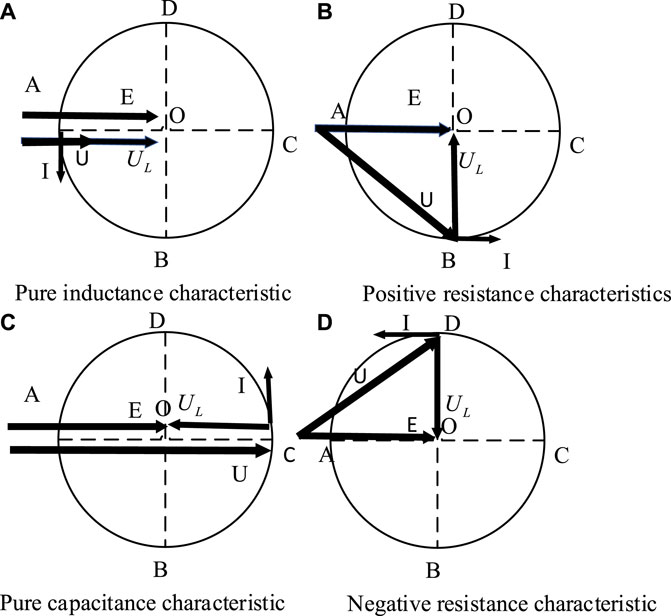
FIGURE 1. Vector diagram of the different load characteristics. E: Grid voltage; I:AC network side phase current; U:AC net-side voltage; UL:Load Voltage; O: zero point of the coordinate system; A,B,C,D: The critical working point of the four quadrants. (A) PCS absorbs reactive power, showing pure inductance characteristics. (B) PCS absorbs active power from the AC busbar on the grid side, showing positive resistance characteristics. (C) PCS releases reactive power, showing pure capacitance characteristics. (D) PCS transmits active power from the AC bus at the grid side, showing negative resistance characteristics.
As shown in Figure 1, the energy storage system can be presented with four characteristics: pure inductance, pure capacitance, positive resistance, and negative resistance, by changing the control strategy to meet the system requirements. As shown in Figure 1A, the voltage phase at the AC network side is the same as that of the electromotive force of the power network, and the phase current lags the voltage by 90°. PCS absorbs reactive power, showing pure inductance characteristics. As shown in Figure 1B, the phase current is in the same phase as the electromotive force of the grid. PCS absorbs active power from the AC busbar on the grid side, showing positive resistance characteristics, and the energy storage system is charging. As shown in Figure 1C, the phase current is 90° ahead of the grid voltage, and PCS releases reactive power, showing pure capacitance characteristics. As shown in Figure 1D, the phase of the grid-side phase current is opposite to the electromotive force of the grid. PCS transmits active power from the AC bus at the grid side, showing negative resistance characteristics, and the energy storage system is in a discharged state (Xiao et al., 2021; Li et al., 2023a).
2.2 Demand analysis and control principle of ESS
As an emerging flexible regulation resource, energy storage can further enhance the regulation potential of existing resources and better support the power grid to adapt to the rapid development of new energy through its bidirectional power characteristics. It has a broad application prospect in new power systems and can play an essential role in new systems with high proportions of renewable energy access (Sun et al., 2020).
2.2.1 Peak shaving and valley filling
In recent years, the proportion of new energy installations with intermittency and uncertainty, such as wind power and photovoltaic sources, has been growing, increasing the pressure of system peaking and the difficulty of grid operation control. Currently, the task of peaking in the power system is mainly undertaken by traditional generating units such as thermal power. Still, many challenges could be solved with conventional units for peaking, mainly including 1) operational safety, in which the sudden load change caused by the traditional unit output changes results in an abnormal loss of unit components, affecting the stable operation of the unit. 2) Cost-effectiveness, in which the peaking cost of thermal power units is higher, including the fuel consumed by frequent start-up and shutdown and the operating energy consumed by prolonged rotating standby. 3) Peaking performance, in which thermal power units cannot quickly increase output power, resulting in long regulation response times and affecting regulation performance (Sun et al., 2022).
Due to the huge peak-to-valley differences in the demand for electricity between times and seasons, energy storage can effectively provide demand-side management with its good charging and discharging capability. Energy storage can allow direct profit through low storage and high generation. Moreover, energy storage also reduces system operation costs, saves investment in peaking units, improves the daily load rate of the power system, and significantly improves the utilization rate of power generation equipment. By reducing system operating costs and saving investments in peaking units, the daily load rate of the power system is improved, and the utilization rate of power generation equipment is greatly enhanced, thus improving the overall operating efficiency of the power grid, reducing the cost of power supply, and generating considerable economic benefits. The energy storage system can also participate in grid peaking by using a constant power charging and discharging control strategy; that is, the battery storage system makes charging and discharging rules according to the historical load curve and provides continuous power to charge and discharge the grid, independent of the real-time load changes.
2.2.2 Frequency regulation
Under the current trend of large-scale grid-connected development of highly proportional distributed energy sources, the imbalance between power supply and demand due to forecast errors and other factors has become more significant and the traditional frequency regulation method based on automatic generation control (AGC) systems to adjust generator output are facing substantial challenges, including 1) rapid output changes to accurately track load changes; 2) small response power reserve margins; 3) battery storage power in response to frequency fluctuations in floating charge state, compared to the peak and valley load of the power grid in depressed areas require deep battery charging and discharging, with limited impact on battery life.
As a high-quality flexible resource, participation in system fast frequency regulation is an important application scenario for energy storage. The droop control strategy shown in Eq. 1 can be used for the participation of an energy storage system in grid-assisted frequency regulation. When the system frequency deviation crosses the set regulation dead zone, the energy storage starts to work and adjusts the power in real time, according to the charging and discharging rules, to maintain frequency stability. In contrast, the energy storage system is idle and does not work when the system frequency deviation is within the dead zone (Stroe et al., 2017; Wu et al., 2015).
where P is the charging and discharging power of the battery storage; k is the gain factor of the battery storage, Δf is the frequency deviation of the system; f0 is the set deadband value, in which the battery storage does not work; and P0 is the charging power of the battery storage at the set regulation deadband.
2.2.3 Voltage regulation
Energy storage has millisecond power response speeds, four-quadrant power regulation capability, and high-power regulation accuracy. It can effectively control the system voltage, and its emitting/absorbing reactive power occupies only the PCS capacity without affecting the charge state of the energy storage system. Thus, the use of energy storage to participate in grid voltage regulation when there is remaining PCS capacity can improve the utilization rate of energy storage power plants.
Few measures are available on the grid side to manage voltage transients. These usually rely on the user side to install management devices to alleviate voltage transients. By moderately charging reactive power through energy storage, the demand for reactive power compensation can be met while ensuring that the voltage does not cross the limit, which provides a new idea for transient voltage management on the grid side.
First, the power flow analysis of the parallel network of the energy storage system, considering that the voltage transverse component is much smaller than its longitudinal component, is used to obtain the voltage of a similar network as in Eq. 2. A sizeable reactive power shortage or fault occurring in the grid will cause PCC bus voltage fluctuation and affect the regular grid operation. When the PCC bus voltage is transformed to U2, the reactive power quantity Qref required to support the PCC point voltage to recover to the rated value UPCCN is shown in Eq. 3, where UPCC, UPCCN, and US are the energy storage grid point voltage, grid voltage rating, and system voltage, respectively. U2 is the grid connection voltage, P and Q are the active and reactive powers issued by the energy storage system, and PL and QL are the active and reactive powers of the load, respectively. When the grid has a reactive power shortage, or a fault occurs, if the energy storage emits the corresponding reactive power as in Eq. 3, it can precisely compensate for the missing reactive power of the grid and support the PCC parallel network voltage to restore the rated value (Lee et al., 2017).
3 Multi-target judgment and smooth switching control
Based on the participation of the energy storage system in typical operating conditions such as peak shaving, frequency regulation, and voltage regulation, the multi-layer judgment logic of energy storage system operation control under different operating conditions was preset. A multi-objective judgment and smooth switching strategy was proposed, as shown in Figure 2, which effectively utilized the idle capacity of the energy storage system, improved the grid power quality, and provided the optimal control of energy storage that considered both technical and economic aspects.
3.1 Multi-level logic judgment
The energy storage system mainly applies to active power output scenarios such as peak shaving, valley filling, and fluctuation smoothing. Therefore, energy storage and peak regulation were the original control targets. The multi-layer logic judgment was made through the constructed energy storage and grid connection evaluation index to determine the optimal control target of energy storage and complete the control strategy switching.
3.1.1 First level of judgment
First, the output data of energy storage units and grid connection status were collected and analyzed to determine the actual demand for energy storage from the grid and obtain the power command of energy storage by intelligent algorithm prediction (Li et al., 2023b; Sun et al., 2023; Sun et al., 2021a). The first layer of judgment aimed to quickly identify whether the voltage and frequency of the energy storage grid connection are in normal condition and assess the need for emergency energy storage support. In this case, if the voltage or frequency is in the emergency support state, the corresponding control strategy is switched without regard for the economic index, as the capacity allows.
The real-time voltage and frequency deviation is selected as the first level judgment index for switching the control strategy of the energy storage system. The energy storage has fast power output and accurate tracking capability, which can make up for the response speed and regulation capability of traditional units and address the sudden change in system frequency. By detecting the real-time voltage and frequency deviation of the energy storage parallel network, energy storage was classified into two working states (emergency support and non-emergency support) based on the deviation value. The first level of evaluation was performed by the first level of the judgment index. When the real-time deviation value exceeded the grid standard, the energy storage system directly switched the control strategy to regulate grid voltage or frequency. Eq. 4 shows that the first level of evaluation indicators were set according to the real-time deviation value to determine whether the grid voltage and frequency required emergency support, i.e., when the energy storage system cannot meet the grid standards. If there is an indicator in the voltage or the frequency for the emergency support state, the energy storage system switches to the corresponding active support control.
3.1.2 Second level of judgment
When the voltage and frequency of the energy storage grid connection point meet the grid connection criteria, a second layer of judgment must be constructed through economic and stability assessment indexes to obtain the optimal control target that simultaneously considers the economic benefits and the grid connection status of energy storage.
First, the stability assessment index of the grid-connected operation state of energy storage was defined: the deviation coefficient of the voltage and frequency of the grid-connected network of energy storage relative to the international standard of grid-connected, in which the larger the deviation coefficient, the weaker the support ability of the system, and the higher the priority of voltage/frequency regulation.
where udead indicates the voltage regulation deadband, Su the voltage regulation stability index, and uref the rated energy storage voltage to the grid. fdead indicates the frequency regulation deadband, Sf the frequency regulation stability index, and fref the rated frequency of energy storage to the grid.
The economic index of energy storage is defined as considering the compensation standard of auxiliary services under different revenue modes in the power market, comprehensively comparing the economic benefits of energy storage under peak regulation, frequency regulation, and voltage regulation, and providing economic evaluation criteria for achieving optimal control of energy storage.
In terms of peak and valley shaving, the energy storage system buys and stores electricity from the grid in the low valley, releases electricity, and sells it to customers in the peak, using the peak–valley price difference to realize arbitrage and gain income from differences between the purchase and sale prices (Zhao et al., 2022). At present, Europe, including Germany, the United Kingdom, France, and other countries, has introduced carbon-neutral policies to provide opportunities to develop energy storage to allow energy storage to participate in the scoring mechanism. Grid companies are similarly reducing the threshold of the wholesale power and power balancing markets. The United States introduced a relevant decree in 2018 to support the participation of energy storage companies in the wholesale power market, laying the foundation for developing energy storage business models.
Taking a Chinese province as an example, the government has constructed an energy storage market with a peak-to-valley tariff, where the peak tariff reaches 0.5 RMB/kWh. The valley tariff reaches 0.4 RMB/kWh, and I1 is defined as the revenue from the participation of energy storage in peaking, C1 is defined as the peaking service capacity in MWh, B1 is the paid peaking of the price of energy storage facilities in peak hours, B2 as the paid peaking of the price of energy storage facilities in trough hours, ηd is the discharge efficiency of the energy storage system, t1 is the peaking time of energy storage in peak hours, and t2 is the peaking time of energy storage in trough hours.
where Pc and Pd denote the average power of the energy storage system during charging or discharging periods, respectively.
The main compensation of frequency regulation includes mileage and capacity compensations, which are mainly calculated based on the frequency regulation mileage and the calling capacity, respectively. This article analyzed mileage compensation as an example (Liu et al., 2021).
where I2 is defined as the revenue brought by the participant of energy storage in frequency regulation, Bf is the paid frequency regulation clearing price of energy storage facilities, Dt is the frequency regulation mileage, Kt is the frequency regulation performance index, and M is the regulation factor, adjusted according to the market operation, tentatively M = 1.
The economic benefits of energy storage participation in grid voltage regulation are mainly capacity compensation benefits, including the compensation obtained from the reduction of active output and the savings obtained from the removal of reactive power compensation equipment. When a voltage warning occurs on the grid, the grid company will release the grid-connected active limit Cpmax, compensation tariff B3, a reactive power demand absorbed or issued by the storage system, and the reactive power tariff BQ. When the active output of the storage system is greater than the active limit, it will not receive the auxiliary service benefit of active reduction; on the contrary, the storage system will receive the corresponding benefit according to the active reduction. The energy storage system emits or absorbs reactive power according to the actual grid demand and obtains the reactive auxiliary service revenue I3.
where CP, CQ, and t3 are the stored active output capacity, reactive output capacity, and the time involved in voltage regulation, respectively.
The energy storage involved in frequency regulation of the dispatching active output and participation in voltage regulation of the reactive production due to the existence of the peaking plan is not an algebraic superposition of the binding relationship; the need to participate in frequency regulation of energy storage and peaking auxiliary service active output coupling calculation, and then further analysis of the coupling of energy storage involved in voltage regulation of the available PCS capacity. When the absolute value of the active output decreases after superposition, the reactive margin of the energy storage increases, which is beneficial to voltage regulation; in contrast, when the absolute value of the active output increases after superposition, the reactive margin of the energy storage decreases, thus reducing the voltage regulation capacity. The final actual active power output and actual reactive power output of the energy storage are related to the PCS capacity; therefore, the capacity index of the energy storage system should also be considered.
where ηC denotes the capacity indicator, Preal and Qreal denote the energy storage system’s active and reactive output values, respectively, and SPCS is the PCS capacity.
The comprehensive evaluation index is defined as a comprehensive index that considers the system economy, the state of energy storage on the grid, and the utilization rate of energy storage capacity to obtain stable and economic grid operation. First, the hierarchical analysis method sets the influence weights of the three graded indicators on the comprehensive evaluation index of peak regulation. Based on an in-depth analysis of the problem, the objectives at each level, the system benefits considered, the technical factors, and the control objects are decomposed into different hierarchical structures. The priority weights of each element of each level on the previous level are then obtained by solving the judgment matrix eigenvectors. Finally, the final weights of the indicators at each level to the integrated target are determined by weighted summation (Jafari et al., 2019). According to the comparison of the influence degree of each index, the comparison matrix A is obtained as follows:
where aii = 1, aij = 1/aji (i,j = 1, 2, 3, 4). After the consistency test of the judgment matrix, we can obtain the coefficients that satisfy each weighting coefficient of the test index.
S1, S2, and S3 are defined as the comprehensive evaluation indexes of energy storage with peak regulation, frequency regulation, and voltage regulation as the control objectives, respectively. λ denotes the impact weight of indicators at each level.
3.2 Control strategy for energy storage system switching
With the participation of energy storage in peaking as the conventional operation scenario, from the long timescale, the energy storage system is divided into two operation scenarios: peaking and non-peaking. The short timescale of frequency regulation and peaking output is considered on this basis. However, due to the different control principles in different operation scenarios, direct switching between different control modes will usually lead to large disturbances or unsuccessful switching. To achieve smooth switching between different control modes, based on the proposed comprehensive index considering the stable and economic operation of the power grid, multi-objective priority ranking was performed using multi-layer judgment logic to obtain the control logic under nine operating conditions to provide multi-objective control and smooth switching of the energy storage system. The flow chart is shown in Figure 3.
(1) By judging Δf(t), Δu(t), identify whether the grid needs emergency active and reactive power support. If so, go to step (2); otherwise, go to step (3).
(2) If either the grid voltage or frequency requires emergency support, switch the response control strategy directly; if both voltage and frequency require emergency support, judge the comprehensive assessment and switch the response control strategy.
(3) Select the optimal control strategy for the stable and economic operation of the grid by judging the comprehensive index.
(4) Judging the capacity margin index, identify whether the energy storage can continue to work. If the capacity is sufficient, enter step (1). If the capacity is insufficient, stop working.
The upper layer system switches the control strategy of the energy storage system according to different working conditions; therefore, the energy storage application scenario is specifically divided into nine working conditions, as shown in Table 1 according to the proposed two-layer judgment index. The corresponding energy storage output scheme is provided as pseudo-code.
The control strategies proposed in Table 1 are shown in Table 2.
4 Discussion
4.1 Simulation analysis
Through MATLAB/Simulink, a simulation model of switching control of the energy storage system based on multi-layer judgment logic was built, as shown in Figure 2. The energy storage system was mainly involved in grid peaking as the long-timescale energy storage control target. The optimal control target was selected in real time based on a comprehensive evaluation index. The power curve, grid voltage, and frequency fluctuation curve of energy storage were selected for analysis. The parameters are shown in Table 3.
First, we simulated the operation status of the energy storage system under normal operating conditions when the voltage and frequency aligned with the grid standard. The real-time power of the energy storage system is shown in Figure 4. At this time, the energy storage takes peak-shaving and valley-filling as the control target and runs according to the set power, and the energy storage runs in the constant power control mode.
To verify the frequency regulation effect of the energy storage system when frequency fluctuations occur in the power system, such fluctuations in the actual power grid were simulated by load throwing and cutting. The frequency fluctuations are shown in Figure 5, in which the proposed control method has a suppression effect on the system frequency fluctuations, and the maximum and average values of the frequency fluctuations are reduced.
At 0.5 s, the system experiences large frequency fluctuations due to load throwing and cutting; the energy storage system judges the switching control target according to the comprehensive index and operates in frequency modulation mode, the PCS uses virtual sag control, and the real-time power is as shown in Figure 6. The traditional constant power control under peaking conditions does not allow adjustment of the system frequency by changing the energy storage power output for frequency fluctuations in the system. In contrast, the method in the present study can switch the strategy in real time and change the energy storage power when the system frequency fluctuates to support the system frequency.
To verify the voltage regulation effect of the energy storage system during voltage fluctuations in the power system, voltage fluctuations in the actual grid were simulated by load throwing. For a load at 0.5 s, the grid voltage deviation is shown in Figure 7, indicating that the proposed method of control has a suppression effect on the system voltage fluctuation.
Currently, the energy storage system takes voltage regulation as the control target, and the PCS adopts reactive-voltage droop control, the reactive power output of which is shown in Figure 8. For the traditional constant power control under the peaking condition, when voltage fluctuation occurs in the system, no timely response is possible to allow the energy storage to participate in the regulation of the system voltage; however, the strategy proposed in the present study can change the reactive power output of the energy storage in real-time to support the grid voltage according to the proposed index.
As shown in Figure 8, in this situation, the energy storage active power output according to the established plan, at 0.5 s due to the grid voltage fluctuations, switches to the voltage regulation mode, while the grid network voltage switches back to the grid standard and then to the peak regulation mode. Figure 9 shows the active and reactive power output of the energy storage system when the grid voltage and frequency fluctuate several times. The grid fluctuates at 0.35 s, 0.45 s, and 0.55 s, respectively, and the energy storage system switches the control target with the grid fluctuation of the power grid to change the power output of energy storage in real-time to effectively support the voltage and frequency of the system and realize real-time optimal control.
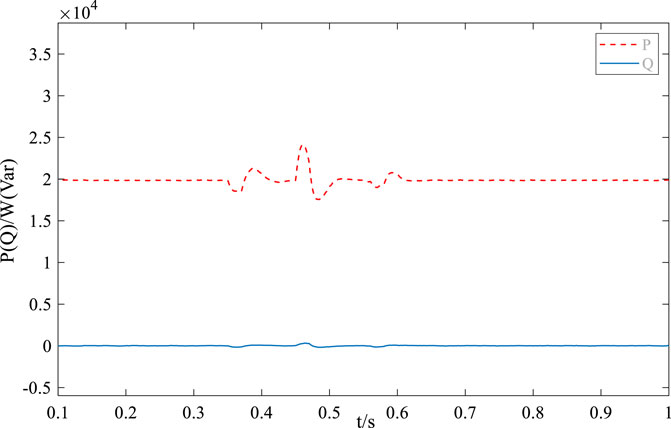
FIGURE 9. Energy storage power output when multiple voltage and frequency fluctuations occur in the system.
4.2 Economic benefit analysis
Using the actual power output data of a local energy storage power station as an example, the power station was charged and discharged at 0:00 and 10:00 to participate in grid peaking, charged with 100 MW power for 1 h at 0:00, and discharged with 85 MW to the grid for 1 h at 10:00. At other times, the power station energy storage was not working. In the actual engineering application, energy storage was not working most of the time, which led to a waste of energy storage resources. The switching control based on multi-layer logic judgment proposed in this article considered the short timescale conditions of frequency and voltage regulation, assuming that the energy storage was dispatched once every 5 min and the call ratio was 80%. In this article, although the energy storage frequency and voltage regulation occupied peak capacity during peak hours, the frequency and voltage regulation services improved the total economic benefits of the energy storage system in short timescales during non-peak hours, which provided compensation benefits in the electricity market for the energy storage system. The results are shown in Table 4. Comparison with economic index I showed that the proposed method improved the economy of the energy storage system, with an approximately 10.8% increase in economic gain compared to the single-target control strategy, which only participates in grid peaking. In addition, the energy storage was deployed for grid frequency and voltage regulation during non-peak hours, which effectively utilized the idle capacity of the energy storage system and improved the energy storage utilization rate.
5 Conclusion
To meet the control requirements of energy storage systems under different power grid operating conditions, improve the energy storage utilization rate, and enhance the support role of energy storage in the power grid, this paper proposes a switching control strategy for an energy storage system based on multi-layer logic judgment to achieve the maximum benefit of energy storage and safe and stable operation of the power grid. First, we analyzed the current situation of multiple auxiliary services demanded by the energy storage system and proposed a comprehensive evaluation index to support switching control of energy storage by considering the economics of the energy storage system and the safe and stable operation of the power grid. Using this information, we proposed a multi-objective judgment and smooth switching strategy based on the participation of an energy storage system in typical operating conditions such as peak-shaving, frequency, and voltage regulation of the grid. The simulation results showed that compared with the traditional energy storage single-target control strategy, the proposed strategy allowed the energy storage system to switch its operation mode according to the real-time voltage and frequency states, which enhanced the support role of energy storage on grid voltage and frequency, improved the power quality of the grid, and effectively reduced the idle rate of the energy storage system to significantly improve the utilization rate of the energy storage system in typical operating conditions such as grid peak shaving, frequency regulation, and voltage regulation. The results of the analysis of the economic benefits showed that the proposed method improved the economic benefit by approximately 10.8% compared with those of the energy storage plant only for peak and valley reduction, which significantly improved the economic benefits of the energy storage system.
The economic efficiency of the energy storage system is an essential factor for its optimal control. This study focused on the benefit analysis of the energy storage system from two aspects: the whole life cycle cost of the energy storage system and the compensation income of the energy storage plant. However, the continuous switching of the energy storage control strategy will inevitably increase the energy storage system loss and its operation cost. Additional studies are needed to quantify the losses generated by this switching and fully consider the additional costs generated by energy storage in operation to meet the demand for the comprehensive benefits of energy storage containing a high percentage of renewable energy to the grid.
Data availability statement
The original contributions presented in the study are included in the article/Supplementary Material. Further inquiries can be directed to the corresponding author.
Author contributions
SD: responsible for resources, software, formal analysis, and program compilation. SYi: responsible for methodology, project administration, and funding acquisition. SYu: responsible for writing the original draft. LR, WX, and WY: responsible for writing review and editing.
Funding
The study in this paper was sponsored by the project supported by State Grid Shandong Electric Power Company of China (5206002000U3). The funder was not involved in the study design, collection, analysis, interpretation of data, the writing of this article, or the decision to submit it for publication.
Conflict of interest
Authors SD, SYi, LR, WX, and WY were employed by State Grid Shandong Electric Power Company.
The remaining author declares that the research was conducted in the absence of any commercial or financial relationships that could be construed as a potential conflict of interest.
Publisher’s note
All claims expressed in this article are solely those of the authors and do not necessarily represent those of their affiliated organizations, or those of the publisher, the editors and the reviewers. Any product that may be evaluated in this article, or claim that may be made by its manufacturer, is not guaranteed or endorsed by the publisher.
References
Chen, C., Li, X., and Zhang, B. (2022). Energy storage peak and frequency modulation cooperative control strategy based on multi-time-scale. Power Syst. Prot. Control 50 (05), 94–105. doi:10.19783/j.cnki.pspc.210857
Chen, Y., Li, P., and Sun, P. (2021). Coordinated control strategy of energy storage system participating in frequency regulation and voltage regulation of power grid by microcomputer. Electr. Eng. 12, 150–152. doi:10.19768/j.cnki.dgjs.2021.12.056
Guo, Y., Wu, Q., Gao, H., Chen, X., Østergaard, J., and Xin, H. (2019). MPC-based coordinated voltage regulation for distribution networks with distributed generation and energy storage system. IEEE Trans. Sustain. Energy 10 (4), 1731–1739. doi:10.1109/TSTE.2018.2869932
Huang, Y., Ding, T., and Li, Y. (2021). Decarbonization technologies and inspirations for the development of novel power systems in the context of carbon neutrality. Proc. CSEE 41 (S1), 28–51. doi:10.13334/j.0258-8013.pcsee.211016
Jafari, M., Brown, L. E., and Gauchia, L. (2019). Hierarchical bayesian model for probabilistic analysis of electric vehicle battery degradation. IEEE Trans. Transp. Electrification 5 (4), 1254–1267. doi:10.1109/TTE.2019.2956350
Jiang, H., Du, E., and Zhu, G. (2020). Review and prospect of seasonal energy storage for power system with high proportion of renewable energy. Automation Electr. Power Syst. 44 (19), 194–207. doi:10.7500/AEPS20200204003
Lee, S. J., KimKim, J. H. C. H., and Kim, D. U. (2017). Coordinated control algorithm for distributed battery energy storage systems for mitigating voltage and frequency deviations. IEEE Trans. Smart Grid 7 (3), 1713–1722. doi:10.1109/TSG.2015.2429919
Li, J., Yuan, X., and Yu, Z. (2019). Comments on power quality enhancement research for power grid by energy storage system. Automation Electr. Power Syst. 43 (8), 15–24. doi:10.7500/AEPS20180826002
Li, X., Deng, T., and Huang, J. (2017). Battery energy storage systems' self-adaptation control strategy in fast frequency regulation. High. Volt. Eng. 43 (7), 2362–2369. doi:10.13336/j.1003-6520.hve.20170628035
Li, X., and Wang, S. (2021). A review on energy management, operation control and application methods for grid battery energy storage systems. CSEE J. Power Energy Syst. 7 (5), 1026–1040. doi:10.17775/CSEEJPES.2019.00160
Li, Y., Sun, Y., Li, K. -J., Sun, K., Liu, Z., and Xu, Q. (2023b). Harmonic modeling of the series-connected multipulse rectifiers under unbalanced conditions. IEEE Trans. Industrial Electron. 70 (7), 6494–6505. doi:10.1109/TIE.2022.3203747
Li, Y., Sun, Y., Wang, Q., Sun, K., Li, K. J., and Zhang, Y. (2023a). Probabilistic harmonic forecasting of the distribution system considering time-varying uncertainties of the distributed energy resources and electrical loads. Appl. Energy 329, 120298. doi:10.1016/j.apenergy.2022.120298
Liu, Q., Liu, M., and Lu, W. (2021). Control method for battery energy storage participating in frequency regulation market considering degradation cost. Power Syst. Technol. 45 (08), 3043–3051. doi:10.13335/j.1000-3673.pst.2020.1407
Ma, L., Xie, L., and Ye, L. (2021). Cooperative operation strategy of dual energy storage under multiple objectives and multiple operation conditions. Automation Electr. Power Syst. 45 (20), 38–48. doi:10.7500/AEPS20200904002
Ma, Q., Wang, H., Luo, P., Chen, H., Liang, J., and Guo, Q. (2022). Real-time control strategy of tractive load peak clipping and valley filling based on model predictive control. IEEE Trans. Transp. Electrification 8 (3), 3208–3218. doi:10.1109/TTE.2022.3163135
Ma, Z., Li, X., and Tan, Z. (2019). Integrated control of primary frequency regulation considering dead band of energy storage. Trans. China Electrotech. Soc. 34 (10), 2102–2115. doi:10.19595/j.cnki.1000-6753.tces.181932
Shi, Y., Xu, B., Wang, D., and Zhang, B. (2017). Using battery storage for peak shaving and frequency regulation: Joint optimization for superlinear gains. IEEE Trans. Power Syst. 33 (3), 2882–2894. doi:10.1109/TPWRS.2017.2749512
Stroe, D. -I., Knap, V., Swierczynski, M., Stroe, A. -I., and Teodorescu, R. (2017). Operation of a grid-connected lithium-ion battery energy storage system for primary frequency regulation: A battery lifetime perspective. IEEE Trans. Industry Appl. 53 (1), 430–438. doi:10.1109/TIA.2016.2616319
Sun, K., Li, K. -J., Zhang, Z., Liang, Y., and Liu, Z. (2022). An integration scheme of renewable energies, hydrogen plant, and logistics center in the suburban power grid. IEEE Trans. Industry Appl. 58 (2), 2771–2779. doi:10.1109/TIA.2021.3111842
Sun, K., Qiu, W., Dong, Y., Zhang, C., Yin, H., Yao, W., et al. (2023). WAMS-based HVDC damping control for cyber attack defense. IEEE Trans. Power Syst. 38 (1), 702–713. doi:10.1109/TPWRS.2022.3168078
Sun, K., Qiu, W., Yao, W., You, S., Yin, H., and Liu, Y. (2021b). Frequency injection based HVDC attack-defense control via squeeze-excitation double CNN. IEEE Trans. Power Syst. 36 (6), 5305–5316. doi:10.1109/TPWRS.2021.3078770
Sun, K., Xiao, H., Pan, J., and Liu, Y. (2021a). VSC-HVDC interties for urban power grid enhancement. IEEE Trans. Power Syst. 36 (5), 4745–4753. doi:10.1109/TPWRS.2021.3067199
Sun, Y., Zhao, Z., Yang, M., Jia, D., Pei, W., and Xu, B. (2020). Overview of energy storage in renewable energy power fluctuation mitigation. CSEE J. Power Energy Syst. 6 (1), 160–173. doi:10.17775/CSEEJPES.2019.01950
Wang, S., Du, L., Fan, X., and Huang, Q. (2021). Deep reinforcement scheduling of energy storage systems for real-time voltage regulation in unbalanced LV networks with high PV penetration. IEEE Trans. Sustain. Energy 12 (4), 2342–2352. doi:10.1109/TSTE.2021.3092961
Wu, L., Gao, W., and Cui, Z. (2015). “A novel frequency regulation strategy with the application of energy storage system for large scale wind power integration,” in 2015 Seventh Annual IEEE Green Technologies Conference, New Orleans, LA, USA, 15-17 April 2015 (IEEE), 221–226. doi:10.1109/GREENTECH.2015.34
Xiao, H., Huang, X., Xu, F., Dai, L., Zhang, Y., Cai, Z., et al. (2022). Improved multiline HVDC circuit breakers with asymmetric conducting branches. Int. J. Electr. Power & Energy Syst. 137, 107882. doi:10.1016/j.ijepes.2021.107882
Xiao, H., Sun, K., Pan, J., Li, Y., and Liu, Y. (2021). Review of hybrid HVDC systems combining line communicated converter and voltage source converter. Int. J. Electr. Power & Energy Syst. 129, 106713. doi:10.1016/j.ijepes.2020.106713
Xu, O., Tang, W., and Cai, Y. (2017). Fuzzy logic based reactive power control strategy for low-voltage distribution networks with high proportion of residential photovoltaic power. Automation Electr. Power Syst. 41 (23), 89–95. doi:10.7500/AEPS20170118014
Yan, X., Cui, S., and Chang, W. (2021). Considering energy storage adaptive adjustment of doubly-fed induction generator control strategy of primary frequency. Trans. China Electrotech. Soc. 36 (5), 1027–1039. doi:10.19595/j.cnki.1000-6753.tces.200308
Yin, R., Sun, H., Sun, Y., Zhao, B., Wang, S., Wu, G., et al. (2023). Non-minimum phase behavior analysis of the weak grid-tied VSC's Q-Axis current control dynamics. IEEE Trans. Power Deliv. 38 (2), 1493–1496. doi:10.1109/TPWRD.2022.3231445
Zhao, S., Wu, Y., and Li, Z. (2022). Analysis of power system peaking capacity and economy considering uncertainty of wind and solar output. Power Syst. Technol. 46 (05), 1752–1761. doi:10.13335/j.1000-3673.pst.2021.0814
Zhou, X., Meng, F., and Li, N. (2021). Control strategies of battery energy storage system participating in peak load regulation of power grid. Therm. Power Gener. 50 (04), 44–50. doi:10.19666/j.rlfd.202004114
Keywords: energy storage, multi-objective control, toggle control, energy storage utilization, economic benefits
Citation: Donglei S, Yi S, Yuanyuan S, Rui L, Xian W and Yao W (2023) Switching control strategy for an energy storage system based on multi-level logic judgment. Front. Energy Res. 11:1199574. doi: 10.3389/fenrg.2023.1199574
Received: 03 April 2023; Accepted: 18 April 2023;
Published: 09 May 2023.
Edited by:
Yuqing Dong, The University of Tennessee, Knoxville, United StatesReviewed by:
Huangqing Xiao, South China University of Technology, ChinaWei Qiu, Hunan University, China
Copyright © 2023 Donglei, Yi, Yuanyuan, Rui, Xian and Yao. This is an open-access article distributed under the terms of the Creative Commons Attribution License (CC BY). The use, distribution or reproduction in other forums is permitted, provided the original author(s) and the copyright owner(s) are credited and that the original publication in this journal is cited, in accordance with accepted academic practice. No use, distribution or reproduction is permitted which does not comply with these terms.
*Correspondence: Sun Yuanyuan, c3VueXlAc2R1LmVkdS5jbg==
 Sun Donglei
Sun Donglei Sun Yi1
Sun Yi1